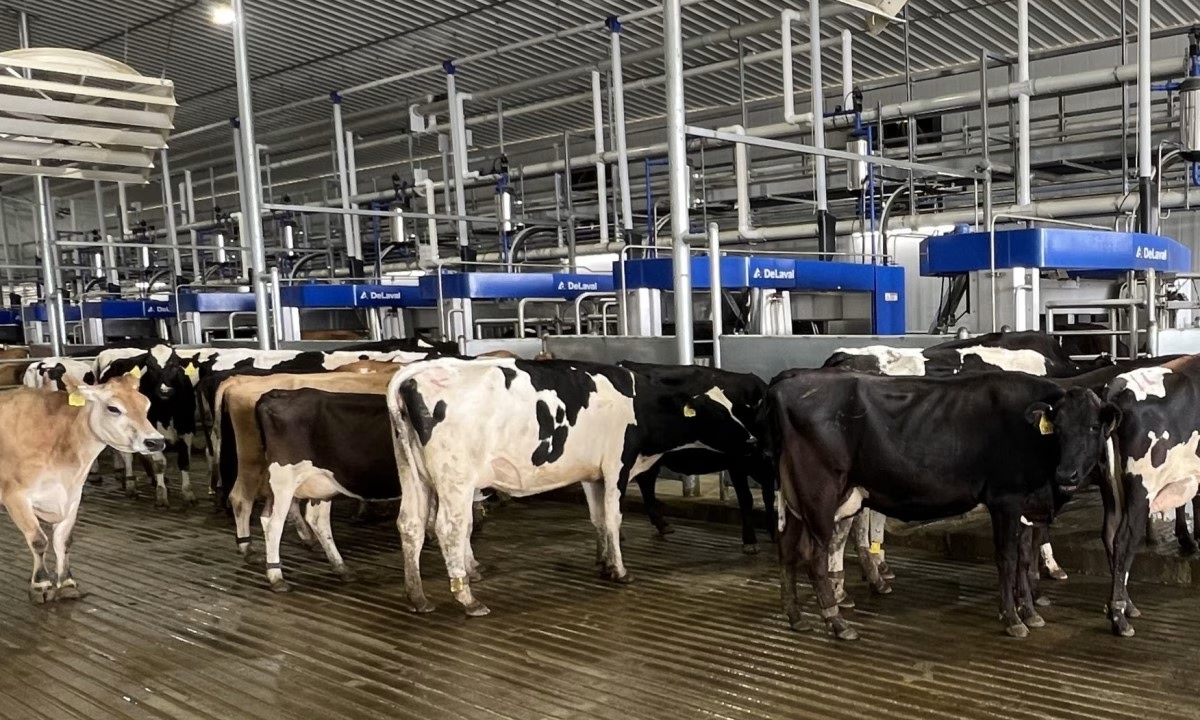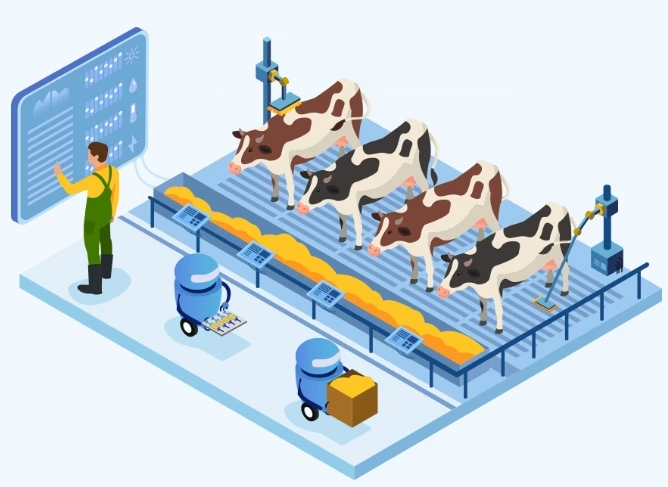Learn how robots in dairy farms can save money and improve productivity. Find practical tips for farmers to cut labor costs and enhance efficiency.

Amidst the challenges of rising labor costs and milk production inefficiencies, robotic automation’s potential to transform dairy farming is a beacon of hope. These modern methods can significantly increase productivity and reduce expenses, offering a promising solution to the financial strain felt by small and medium-sized dairies, especially those with 400 or fewer cows. While the initial investment and effective cost-cutting plan are significant, understanding the proper timing and deployment of these technologies is critical to success in today’s competitive agricultural world.
Revolutionizing Dairy Farming: Beyond Labor Reduction
Robotic systems in dairy farming offer a wealth of benefits beyond labor savings. Automated milking systems, for instance, improve efficiency and consistency, leading to a potential increase in milk production of five to six pounds per cow daily. This improvement is not just about numbers; it’s about your cows’ increased comfort and decreased stress, leading to healthier and more productive animals.
Furthermore, robots enhance animal health monitoring. Advanced sensors and data-collecting systems enable farmers to monitor health indicators such as mastitis and lameness, allowing for early diagnosis and intervention.
Robotic systems also maintain constant feeding schedules. Automated feeders regularly provide accurate feed volumes, boosting nutrition and milk production. This improves herd nutrition and matches feeding with operational objectives.
Finally, these robotic technologies help farmers manage enormous herds more effectively. Increased data availability and analysis promote a more refined agricultural technique, improving production and animal well-being.
Evaluating the True Cost and Labor Dynamics of Robotic Milking Systems
While robotic milking systems provide increased productivity and significant cost savings, it is critical to recognize the limitations and myths. A prevalent misperception is that implementing robotic technology automatically reduces labor expenses. This misses essential elements that contribute to higher costs.
First, the initial investment in robotic milking systems is significant. Dairy farmers and smaller companies face enormous financial burdens from installation, maintenance, and retrofitting expenditures. Although robots do mundane duties, they need frequent, specialized maintenance, which typically increases upkeep expenses. Because of the intricacy of this equipment, farmers may need to engage technical personnel, which may increase operating costs.
Another area for improvement is the widespread misperception regarding labor reduction. The need for skilled labor often fluctuates rather than diminishes. Skilled humans must monitor robots, deal with technological concerns, and analyze data. This transition may raise labor expenses, especially if existing workers need upskilling or new personnel are employed.
Finally, the successful integration of robotic systems depends on farmers’ capacity to adapt to new processes and use data well. Workforce cost reductions depend on owners’ active participation and willingness to reorganize their workforce distribution. This hands-on approach may realize prospective savings, compromising the investment’s financial sustainability. However, it’s important to note that the role of the farmer in the robotic system is not diminished. Instead, it evolves into a more managerial and strategic one, overseeing the robots and making decisions based on the data they provide.
Robotic milking systems can potentially transform dairy production, but it is critical to understand their costs and limitations. Farmers must examine these factors to ensure the move is consistent with their operational capabilities and financial objectives.
Hands-On Engagement: The Key to Maximizing Robotic Efficiency in Dairy Farming
Industry experts recommend a hands-on approach to incorporating robotic technology in dairy production. This approach empowers you, the farm owner, to actively participate in everyday tasks, keeping the farm running smoothly and maximizing robot utilization. Monitoring animal behavior and system performance can increase cow comfort and productivity. This hands-on approach allows for faster identification and resolution of problems, minimizing downtime and maintenance disruptions and promoting informed decision-making. Your active involvement is the key to maximizing the efficiency of your robotic systems and reducing costs.
Strategic Hands-On Involvement: A Pathway to Cost Reduction
One effective technique for lowering labor expenses is for farm owners to take on essential duties, such as monitoring feeding operations or managing the herd. They may save money on employing new employees by conducting these activities themselves. Outsourcing specialized operations that often need expensive services, such as veterinary care, equipment maintenance, or financial administration, might result in considerable savings. Implementing a cross-training program enables personnel to do many jobs, including hoof trimming and breeding. This technique improves efficiency, decreases the need for specialist people, and cuts labor expenses.
The Bottom Line
Integrating robotics into dairy production offers the dramatic potential to increase productivity and simplify processes. However, technology alone does not guarantee cost savings. Significant labor reductions depend on the active participation of farm owners. Proper administration, efficient feeding programs, and personnel cross-training are critical for improving robotic systems and lowering expenses.
Milk output per cow, labor efficiency, and robot longevity all influence profitability, stressing the need for hands-on engagement. As technology advances, farmers must adapt while remaining engaged. This balance is crucial for dairy enterprises’ competitiveness and long-term sustainability.
To dairy farmers: embrace technology enthusiastically while remaining active in your business. Your leadership and aggressive management are critical to converting potential efficiency into savings. The future of dairy farming depends on combining technology and committed human oversight.
Key Takeaways:
- Robotic systems can enhance overall efficiency but may not always translate into reduced labor costs for dairy farms.
- Effective labor cost reduction is contingent upon a hands-on approach from farm owners, especially in dairies with 400 or fewer cows.
- Owners might find themselves taking on roles such as feeding or herding to keep overheads low.
- Outsourcing certain services and cross-training employees in essential skills can further support labor cost reductions.
- Success with robotic systems necessitates a meticulous evaluation of costs and a strategic, hands-on management style to truly reap financial benefits.
Summary:
Robotic automation has the potential to revolutionize dairy farming by increasing productivity and reducing costs, especially for small and medium-sized dairies with 400 or fewer cows. Automated milking systems can increase milk production by five to six pounds per cow daily, leading to healthier and more productive animals. They also enhance animal health monitoring, allowing for early diagnosis and intervention. Automated feeders provide accurate feed volumes, boosting nutrition and milk production. However, the initial investment in robotic systems is significant, and the need for skilled labor often fluctuates. The successful integration of robotic systems depends on farmers’ ability to adapt to new processes and use data effectively. Workforce cost reductions depend on active farm owner participation, proper administration, efficient feeding programs, and personnel cross-training. Milk output per cow, labor efficiency, and robot longevity all influence profitability, emphasizing the need for hands-on engagement. As technology advances, farmers must adapt while remaining active in their business for dairy enterprises’ competitiveness and long-term sustainability.












